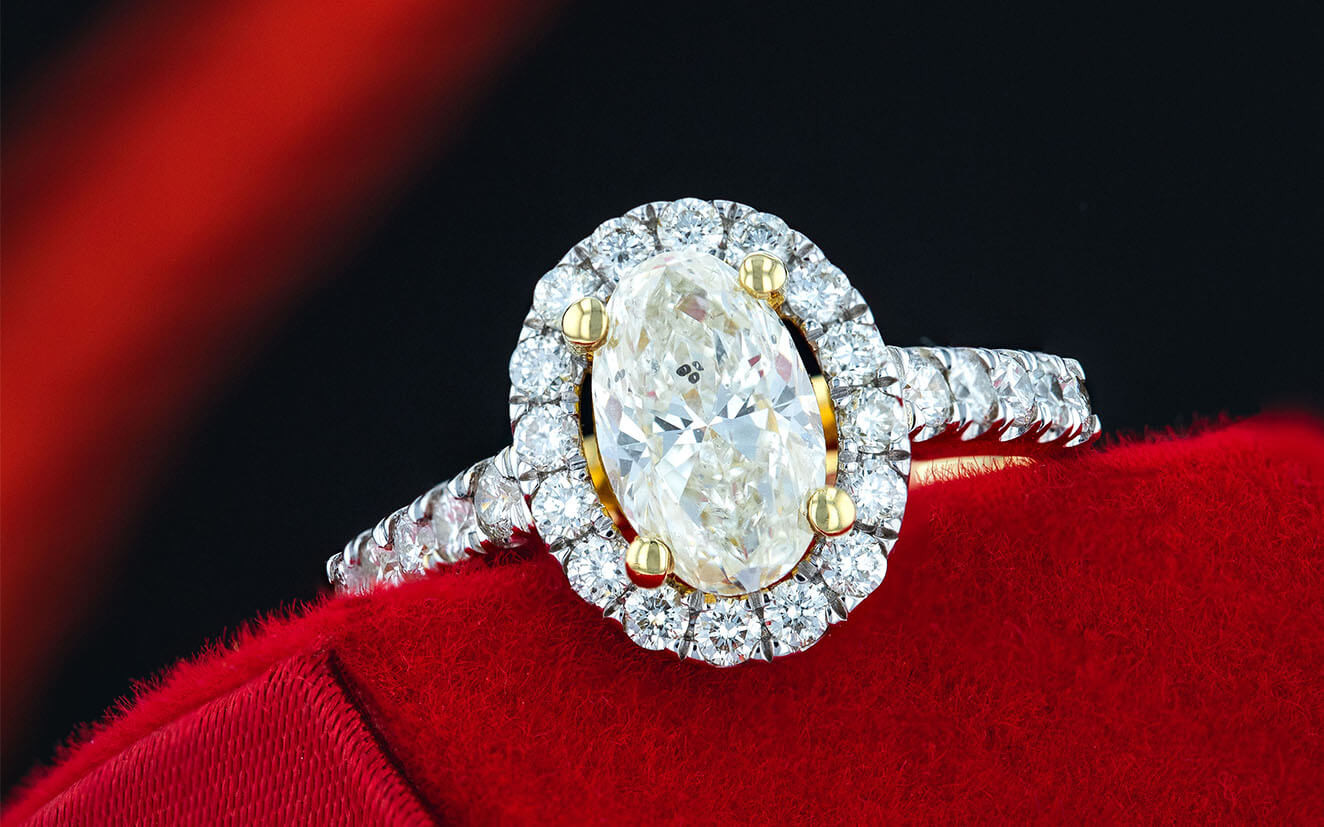
Last year, a funny thing happened at Ring Concierge’s Manhattan showroom. A bride-to-be brought her engagement ring back to the popular jewelry store after wearing it for a few weeks and wanted to trade out her diamond for a worse one. The woman was worried that the original rock was too clear, too bright, too perfect for its large size, Ring Concierge’s CEO, Nicole Wegman, told me. She wanted to replace it with a lower-quality stone of a similar size—something a little less bright white.

Brides sometimes bring in new rings for tweaks; maybe they want the fit adjusted, or they’re having second thoughts about the setting. Occasionally, they decide they want to pay the extra money to go bigger. That the central diamond is too good, however, is just not a complaint that jewelers get, except in cases of totally blown budgets. But this particular bride wasn’t worried that she’d spent too much money, Wegman said. In a sense, the bride was worried that she hadn’t spent enough. She and her fiancé had selected a lab-grown diamond—a gem that’s chemically identical to a mined diamond at a fraction of the cost—in order to get the kind of size and clarity that would push a natural stone far beyond their means. Now she was concerned that everyone they knew would take one look at the big, perfect stone on her finger and immediately see the trade-off.
In recent years, lab-grown diamonds have flooded into the market, causing something of an existential crisis in the natural-diamond industry, which has spent decades making the diamond engagement ring into a singular goliath of American luxury shopping. This new wave of stones offers a tempting bargain: You can have the ring of your dreams (or something much closer to it), even if your budget is significantly smaller than the average ring cost of somewhere around $5,500. A real stone—and its symbolic value in life and romance—no longer requires all that expense, or all of the baggage of mined stones’ bloody imperial history. Diamonds, it would seem, are now a solved problem.
Except, of course, a diamond’s appeal has never had that much to do with the chemical specifications or atomic structure of the stone itself. Even as lab-diamond sales have taken off, Wegman told me, most buyers have the same approach as that regretful bride. They want to stick to a stone that would still seem plausible for their income and status were it mined, and they don’t plan to tell their family and friends that it’s not. The rationality of lab-grown diamonds is butting up against an even greater force: the cultural power of their mined counterparts, built on a generations-long influence campaign to change the way Americans think about marking personal milestones. In the end, it’s a fight that lab-grown-diamond purveyors actually might not want to win.

Diamonds, as you have probably heard before—perhaps from someone trying to get out of buying one—are just chunks of carbon. More precisely, they are chunks of carbon that form more than 100 kilometers belowground, some of which are eventually carried by volcanic activity back toward the surface, where they can be reached by miners. To make a diamond, nature requests your patience. The timeline is rather lengthy—on the order of millions, if not billions, of years. In that span, heat and pressure arrange the carbon’s atoms in a crystal structure that lends the resulting rocks their strength and sparkle. This process also grants diamonds a whole host of plausible symbolic meanings—eternal commitment, enduring love, that sort of thing—arguably as important to their commercial appeal as any of their physical properties.
Natural diamonds are generally pit mined—a difficult, dangerous process in which they are hauled by humans out of great human-made craters in the earth—and they can develop in only a handful of rock varieties. Deposits of those rocks can be found on every continent, but relatively few of them are diamondiferous (delightfully, that’s the real word for it); even fewer are close enough to the surface to be mined. The most productive mines can yield enormous quantities of diamonds annually, but only a fraction of those stones will have physical characteristics that the industry considers desirable for jewelry.
For generations, De Beers—a British–South African mining corporation that the journalist Edward Jay Epstein described in a now-legendary 1982 Atlantic exposé on the industry as “the most successful cartel arrangement in the annals of modern commerce”—controlled enough of the trade to meter the supply of jewelry-quality stones released to the consumer market, ensuring a sense of scarcity and high, stable prices. Over the past few decades, however, De Beers’s influence has waned. According to Edahn Golan, a diamond-industry analyst and a managing partner at the jewelry-analytics firm Tenoris, supply has become more responsive to consumer demand. This is one reason, he told me, that “the industry’s economics are more wobbly these days.” Sometimes stones are scarce, as they became during the post-pandemic rush for delayed proposals and weddings. By the time that pent-up demand petered out, jewelers had stocked up, and diamonds were in surplus. Prices dipped.
You can probably understand the appeal of an identical product that feels a little more orderly, more precise, more modern—especially if all that efficiency is cheaper. Lab diamonds promise exactly that: beautiful stones created with industrial predictability and control. The first lab diamonds were produced in the 1950s, but decades of additional research were needed to refine a commercially viable process that can consistently produce customizable, gem-quality diamonds. Now what takes nature perhaps a billion years and a great deal of happenstance can be accomplished in a factory in a few weeks with the right machinery, the right materials—including a sliver of diamond that acts as a seed—and enough skilled technicians. (The lab moniker is something of a not-inconvenient misnomer. It may imbue the stones with an air of white-coated technological precision, but the stones themselves come from a less glamorous industrial setting.)
A one-carat round mined diamond—the kind that anchors a huge proportion of American engagement rings—currently costs anywhere from $50 to $1,000 to produce in its rough form, depending on where it’s mined, according to Golan. In a lab setting, that same diamond now costs $15 to $20 to manufacture. At retail, a lab-grown diamond will generally sell to a consumer for less (and sometimes much less) than half of what a mined stone with near-identical characteristics sells for. Even the Gemological Institute of America, or GIA—a highly influential industry organization that provides, among other things, widely accepted standards of diamond grading that help determine a stone’s worth—has stopped referring to lab-grown diamonds as synthetic. They’re real. No caveats.
You don’t have to be especially skilled at math to discern the grave disruption that this confluence of circumstances could cause for the traditional diamond industry, and some growers have marketed themselves to the public as exactly that. When new materials come along that promise far lower prices, greater predictability, and more advanced technology, manufacturers are generally happy to give them a try. Some of the biggest jewelry and watch brands in the world, including Pandora and Breitling, have either moved their diamond usage entirely to lab stones or pledged to finish that transition in the near future. Russell Shor, a veteran of the diamond industry who spent almost two decades as the senior market analyst for GIA, told me that according to some of the estimates he’s seen, lab diamonds accounted for 30 to 40 percent of the engagement-ring stones sold in the United States last year—a serious encroachment on a crucial sector of the natural-diamond business. Overall, the numbers are impressive: In 2016, about $1 billion’s worth of lab diamonds was sold worldwide. By 2022, the total was $12 billion, which constitutes about 17 percent of the global diamond market, according to Golan.
Diamond growers aren’t just competing against purveyors of mined gems; they’re competing against one another for dominance of a market that is not yet mature. This competition is rapidly driving down prices as the sales numbers shoot up. New players can buy a few machines, lease some factory space in a country with cheap labor, and start churning out low-quality lab-grown gemstones in short order, relative to how long it would take to spin up a fresh pit mine. (Like natural diamonds, lab-grown stones can have occlusions or wonky colors, and those grown too quickly develop what can only be described as stretch marks.) What has happened is exactly what you’d expect when supply far, far exceeds demand: According to Golan’s data, at the end of 2018, the average wholesale price for a one-carat round lab diamond was $1,786. At the end of 2023, it was $163. “It’s a race to the bottom,” Shor said. Retail prices have not collapsed quite as quickly, but they, too, are trending down in rather dramatic fashion.
:max_bytes(150000):strip_icc()/notext-16871b800680458bb84ddd31860d90a3.jpg)
:max_bytes(150000):strip_icc()/notext-16871b800680458bb84ddd31860d90a3.jpg)
On one level, that’s great. Diamonds have endured as a part of engagement jewelry for lots of reasons that have little to do with practicality, but the stones’ characteristics—chiefly their incredible durability and neutral color—do make them a reasonable choice, in purely physical terms, for jewelry you intend to wear on your hand every day for decades. If big, flawless diamonds are no longer even plausibly rare or difficult to source, then people who want a diamond of any sort can simply choose the size and shape that suits them best and not worry about their budget—or about what their diamond says about their position within old-fashioned ideas of status and hierarchy.
Except, well, what if all of that is still sort of the point? Lots of people want to give or receive big diamonds because of their implications, not in spite of them—especially when it comes to wedding jewelry, where price is so freighted with meaning. Wegman, Ring Concierge’s CEO, was skeptical of the idea that price had become incidental to the appeal of a diamond engagement ring. “Lab-diamond prices will have to bottom out at some point, but if they go too low, then is it not going to be enough for an engagement ring?” she asked. “If they start selling for $1,000, let’s say, instead of the $8,000 that they might be selling for today, are women going to feel comfortable with that being the price of their engagement ring, even though it is a diamond?”
The idea that receiving a big, beautiful diamond engagement ring might be less exciting if that ring doesn’t strain your beloved’s budget is, of course, a boon to those in the business of selling jewelry, no matter what kinds of diamonds are in their inventory. It’s also inherent to what Epstein termed “the diamond invention” back in 1982. A decades-long media campaign funded by the De Beers cartel didn’t just ensconce diamond rings as the default symbol of American betrothal; in order to goose sales of larger diamonds, it also painted the stone’s size as a shorthand for a couple’s personal and professional success. The expense itself has always been what makes the ring meaningful.
Why anyone would long to spend extra money when far more affordable, identically useful options abound can be a maddening question—but only when asked about products you’re not personally interested in. You may not feel that way about diamonds, but maybe sports cars or designer handbags or rare whiskeys do it for you. These are all known as “Veblen goods,” so named after the American economist Thorstein Veblen, who first described the phenomenon in 1899. Veblen goods are products for which demand increases as their price goes up, even though improvements in practical utility are marginal at best. People come up with all kinds of arguments for why any particular Veblen good is totally worth the money in rational terms—fine craftsmanship, superior materials, that sort of thing. Sometimes, those assertions are true enough, but they’re not complete. A Veblen good’s primary utility is for social signaling; it derives value from its price, instead of the other way around. It’s desirable because people with less money can’t have it.
All of this puts lab-grown diamond purveyors in an awkward position. Sellers are cratering prices and rapidly expanding supply for a product that needs to be expensive and rare-seeming in order to remain desirable. If a Veblen good suddenly declines in price, demand increases in the short term, as people rush to access status signifiers that would have previously been out of reach for them. But in the long term, these dynamics can spell the end of a Veblen good’s power. As its effect as a status symbol becomes too diluted to be useful for people with actual status, those people eventually move on to other things, and the good begins to lose its aspirational appeal. If lab-grown diamonds become too cheap, in other words, they pose an existential threat to themselves by ruining the demand for diamonds altogether.
Lab-diamond makers, for their part, tend to argue that they’re not just creating a diamond alternative for people who can’t afford the mined version they’d prefer. Their product is also more ethical and sustainable—attributes constantly said to be of incredible importance to the young people who make up most of the engagement-ring market. It is, to be fair, not difficult to imagine that the relative sustainability claims would be at least notionally true: Diamond mining historically has earned its reputation for cruelty and excess, even if the modern industry has made efforts to clean up the worst offenses of generations past. But public proof of lab growers’ sustainability claims can be thin on the ground. And no clear evidence exists that many diamond shoppers are excited enough about an environmentally friendly sales pitch to switch their preference if price isn’t already a concern. No matter how anyone ignores or sanitizes it, after all, part of the appeal of luxury goods is the difficulty or danger involved in service of the buyer’s pleasure.
Lab diamonds are just as sparkly and beautiful as their mined counterparts, but they aren’t a product that has much clear value if people aren’t still being driven mad by desire for the mined diamonds they currently seek to undercut. Counterintuitive though it may seem, that’s great news for the traditional diamond trade—lab stones’ explosive popularity might actually strengthen demand for at least some types of mined diamonds, rather than subvert it. This outcome would be mutually beneficial to growers, miners, and jewelers who deal in any of these products. Mined diamonds would retain their status as Veblen goods, which would in turn help keep retail prices for lab-grown jewelry high (but still a solid deal by comparison), which means that jewelers keep their margins and have more options to offer potential customers. In the end, everyone I spoke with thought that lab-grown diamonds would likely end up just inducing additional demand for diamond jewelry of all kinds, if all the industry players were smart about it.
You can already see that beginning to happen in the numbers, if you look carefully: The size of the average American natural-diamond engagement ring, Golan said, has begun to creep up in the past few years. It used to be about a carat, and now it’s up to 1.2 or 1.3—a phenomenon that he attributed to the proliferation of big lab-grown stones, which make smaller natural diamonds look extra small in comparison, thereby encouraging those buyers to expand their budget to keep up. Buyers could also enter the market for fine jewelry at a younger age and lower price point with lab diamonds, and then “upgrade” to natural stones as they get older, get engaged, and make more money—something Shor said he also expected to see as the owners of lab engagement rings grow older. Upgrading your diamond and expanding your collection along with your socioeconomic status, after all, has long been a part of the diamond invention.
At Ring Concierge, Wegman has so far been reluctant to expand lab diamonds outside of the engagement-ring business, although the company offers a full line of other fine jewelry with mined diamonds. But as time goes on, she said, customers have begun to ask for lab options in other styles—even those who want a mined diamond for their engagement ring. The two types of products are beginning to look more complementary than competitive. This past Black Friday, Ring Concierge dipped its toe into those waters for the first time, offering a pair of lab-diamond stud earrings—a style that Wegman said is a financial stretch for almost everyone when using mined diamonds, because it requires two big stones. The earrings were a hit.






